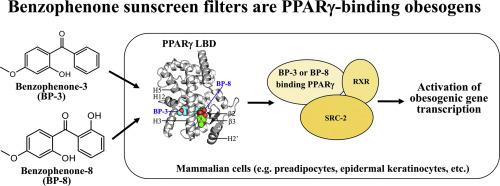当前位置:
X-MOL 学术
›
Toxicol. In Vitro
›
论文详情
Our official English website, www.x-mol.net, welcomes your
feedback! (Note: you will need to create a separate account there.)
Benzophenone-3 and benzophenone-8 exhibit obesogenic activity via peroxisome proliferator-activated receptor γ pathway.
Toxicology in Vitro ( IF 2.6 ) Pub Date : 2020-05-11 , DOI: 10.1016/j.tiv.2020.104886 Jeayoung C Shin 1 , Eunyoung Lee 2 , Seungchan An 1 , Sun Hee Jin 1 , Jaehyoun Ha 3 , Won Jun Choi 4 , Minsoo Noh 1
Toxicology in Vitro ( IF 2.6 ) Pub Date : 2020-05-11 , DOI: 10.1016/j.tiv.2020.104886 Jeayoung C Shin 1 , Eunyoung Lee 2 , Seungchan An 1 , Sun Hee Jin 1 , Jaehyoun Ha 3 , Won Jun Choi 4 , Minsoo Noh 1
Affiliation

|
Benzophenone-3 (BP-3) and benzopenone-8 (BP-8) are commonly used ultraviolet (UV) filter ingredients in diverse sunscreen products. Recently, the obesogenic activity of avobenzone, a long wave UV A filter, was elucidated in the adipogenesis model of human bone marrow mesenchymal stem cells (hBM-MSCs). In this study, the obesogenic potentials of BP-3 and BP-8 were investigated because of their chemical similarity to avobenzone. During the adipogenesis in hBM-MSCs, BP-3 and BP-8 (EC50, 25.05 and 43.20 μM, respectively) potently promoted adiponectin secretion than avobenzone (EC50, 72.69 μM). In target identification, both BP-3 and BP-8 directly bound to peroxisome proliferator-activated receptor γ (PPARγ), which was associated with the recruitment of steroid receptor coactivator-2 (SRC-2). BP-3 functioned as a PPARγ full agonist whereas BP-8 was a PPARγ partial agonist. In addition, BP-3 and BP-8 significantly increased the gene transcription of PPARα, PPARγ, and major lipid metabolism-associated enzymes in human epidermal keratinocytes, a major target site of UV filters in human skin. This study suggests that BP-3 and BP-8 are obesogenic environmental chemicals similar to phthalates, bisphenols, and organotins.
中文翻译:

苯甲酮3和二苯甲酮8通过过氧化物酶体增殖物激活的受体γ途径表现出致肥胖活性。
苯甲酮3(BP-3)和苯甲酮8(BP-8)是各种防晒产品中常用的紫外线(UV)过滤成分。最近,在人骨髓间充质干细胞(hBM-MSC)的脂肪形成模型中阐明了长波UV A过滤剂阿伏苯宗的致肥胖作用。在这项研究中,对BP-3和BP-8的致肥胖潜力进行了研究,因为它们与阿伏苯宗具有化学相似性。在hBM-MSC的脂肪形成过程中,BP-3和BP-8(分别为EC50、25.05和43.20μM)比阿伏苯宗(EC50,72.69μM)更有效地促进脂联素分泌。在目标识别中,BP-3和BP-8都直接与过氧化物酶体增殖物激活受体γ(PPARγ)结合,这与类固醇受体共激活因子2(SRC-2)的募集有关。BP-3充当PPARγ完全激动剂,而BP-8则充当PPARγ部分激动剂。此外,BP-3和BP-8显着增加了人表皮角质形成细胞中PPARα,PPARγ和主要脂质代谢相关酶的基因转录,而人表皮角质形成细胞是人皮肤中紫外线过滤剂的主要靶位。这项研究表明BP-3和BP-8是致肥胖的环境化学物质,与邻苯二甲酸盐,双酚和有机锡相似。
更新日期:2020-05-11
中文翻译:

苯甲酮3和二苯甲酮8通过过氧化物酶体增殖物激活的受体γ途径表现出致肥胖活性。
苯甲酮3(BP-3)和苯甲酮8(BP-8)是各种防晒产品中常用的紫外线(UV)过滤成分。最近,在人骨髓间充质干细胞(hBM-MSC)的脂肪形成模型中阐明了长波UV A过滤剂阿伏苯宗的致肥胖作用。在这项研究中,对BP-3和BP-8的致肥胖潜力进行了研究,因为它们与阿伏苯宗具有化学相似性。在hBM-MSC的脂肪形成过程中,BP-3和BP-8(分别为EC50、25.05和43.20μM)比阿伏苯宗(EC50,72.69μM)更有效地促进脂联素分泌。在目标识别中,BP-3和BP-8都直接与过氧化物酶体增殖物激活受体γ(PPARγ)结合,这与类固醇受体共激活因子2(SRC-2)的募集有关。BP-3充当PPARγ完全激动剂,而BP-8则充当PPARγ部分激动剂。此外,BP-3和BP-8显着增加了人表皮角质形成细胞中PPARα,PPARγ和主要脂质代谢相关酶的基因转录,而人表皮角质形成细胞是人皮肤中紫外线过滤剂的主要靶位。这项研究表明BP-3和BP-8是致肥胖的环境化学物质,与邻苯二甲酸盐,双酚和有机锡相似。











































 京公网安备 11010802027423号
京公网安备 11010802027423号